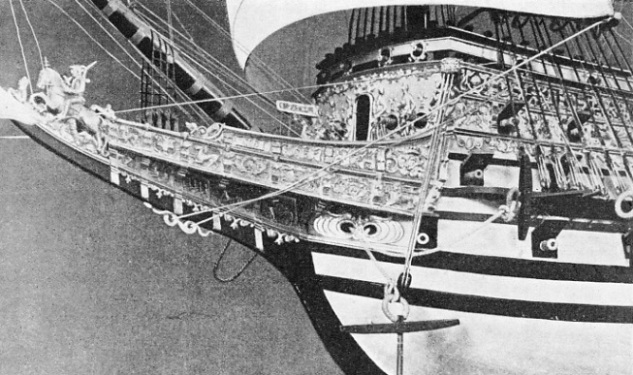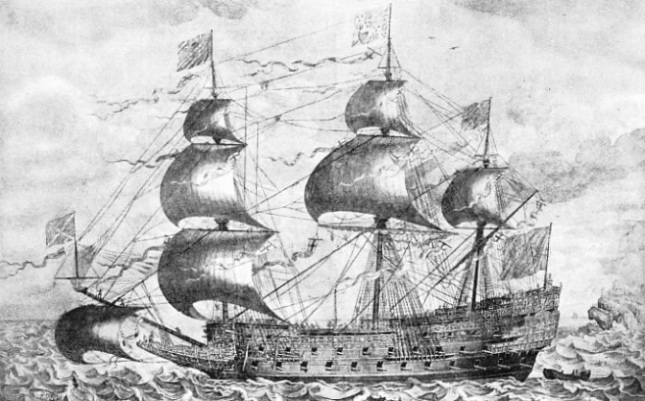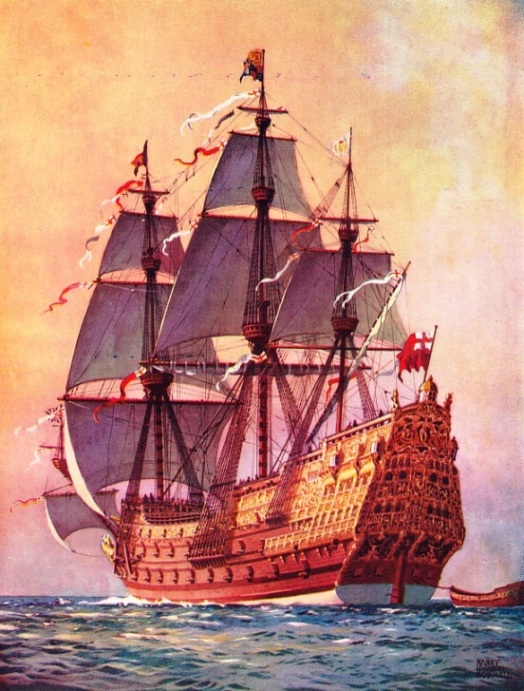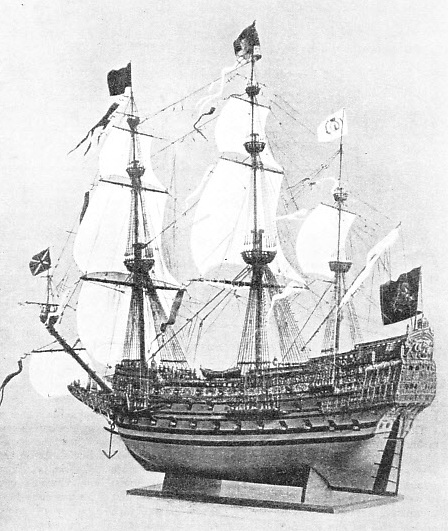

© Shipping Wonders of the World 2012-

The “Sovereign of the Seas”
At the command of King Charles I, the famous “Sovereign of the Seas” was built in 1637. She cost more than £40,000 -

AN EXAGGERATED BEAK HEAD in the Sovereign of the Seas provided magnificent scope for a lavish and elaborate figurehead. The carving represented King Edgar on horseback trampling on the Seven Kings. On the forward bulkhead were six emblematic statues. This illustration shows the details of a model made by Henry B. Culver of New York.
EVERY period of naval architecture has produced its wonder ship. In the history of the British fleet there are many conspicuous wonder ships from the Great Harry to the Hood. Perhaps the most interesting of all is the Sovereign of the Seas, built in 1637. Not only was she an outstanding vessel in design and history, but also she had a material influence on the whole course of Britain’s story.
Her origin was due to King Charles I, who at that time fully appreciated the importance of the Navy to the country’s safety. He outlined the plans of the mightiest ship which had ever been conceived, a vessel of no less than 1,500 tons burden.
The naval experts of the day were staggered at the suggestion. The Brethren of Trinity House, already hard put to it to maintain the ports and fairways in navigable condition with little money, protested that, even if she could be built with safety, such a ship was far too big to be practical. But the King was adamant; he had made up his mind to have the finest man-
Having secured the consent of a reluctant Admiralty, he instructed Phineas Pett, the most prominent naval architect of that day, to prepare a full model of the projected ship. Pett conferred with such noteworthy colleagues as Sir John Pennington, Sir Robert Mansell and Master John Wells, the storekeeper at Deptford Dockyard. Eventually, apparently after much argument, they produced a plan for a ship which was estimated to cost £13,680. The King was graciously pleased to approve, and Pett was ordered to superintend the building of the ship.
Immediately the plans were passed Pett went to the north of England to select and prepare the necessary timber, for it was doubtful if the Home Counties could produce what was wanted. Workmen with all their stores and provisions were sent by water to Newcastle-
On December 21, 1635, a certain amount of material having arrived, the keel of the ship was laid at Woolwich Dockyard. She demanded all the resources not only of Woolwich, but also of Deptford. Even so, it took twenty months to bring her to the launching stage, and it was obvious that the estimated cost would be much exceeded. The wages bill alone was nearly £21,000 and the total cost was finally returned at £40,833 8s. 1½d. This included no less than £6,691 for decoration.
While the ship was on the stocks the King’s enthusiasm increased steadily. He paid a number of visits to Woolwich Dockyard to watch the progress. As is usual in a Court, the fashion became general, and the mighty ship was the great topic of conversation. The King’s interest appears to have been practical, for he noticed the amount of waste material that was collecting round the slip -

JOHN PAYNE’S FAMOUS CONTEMPORARY ENGRAVING of the Sovereign of the Seas shows that she was unique because she set royals on foremast and mainmast and a topgallant sail on the mizen. These sails were not generally used until later by English men-
It was planned that she should be launched on September 25, 1637, in the presence of the King and Queen, the whole court and a large party of guests. About £500 were spent on preparations for the launch and the entertainment of the party, from which selected members boarded the ship on the stocks and thoroughly examined her.
Then came the fiasco. She stuck fast and nothing could move her. There was consternation among the dockyard officials, but the King was reasonable and recognized that it could not be helped. He promised to come down on the next favourable opportunity, and the launch was fixed for the spring tide of October 14.
On the Saturday night before the date of the launch a heavy gale from the eastward brought an abnormal tide up the river and the ship was in danger of dashing herself to pieces. So the master builder of Woolwich took on himself the responsibility of launching her and getting her made fast to the wharf. The King was then in residence at Hampton Court, too far away to be called, but Pett rode post-
The situation was hurriedly explained and Sir Robert rode back to the dockyard with him to perform the christening ceremony. In those days it was always held after the ship was afloat. The picturesque ceremony was carried out by the flickering light of torches in a full gale and must have been one of the most impressive ever held.
The Navy’s First Three-
While the ship was being rigged at Woolwich the King again visited her and looked into every detail closely. She was certainly a ship in which he could take pride as she lay there by the fitting-
Her towering stern dwarfed the bow, which was built with the exaggerated beak head that had been inherited from the galley and which was to cost the Navy many lives before it went out of fashion. This beak gave a wonderful opportunity for decoration. The elaborately carved figurehead represented King Edgar on horseback trampling on the Seven Kings. On the stem Cupid bestrode a lion and on the forward bulkhead six emblematic statues were placed. The stern offered even greater opportunity for masses of elaborate carving and decoration.
Her dimensions were given as 127 feet on the keel, 167 ft 9 in overall, with a beam of 48 ft 4 in and a draught of more than 19 feet. Her tonnage by the old measurement was 1,683, and she was intended to have a complement of 600 men. Her high sides and lofty rig offered tremendous resistance to the wind and her design provided for no fewer than eleven anchors, of which the biggest weighed 4,400 lb.

THE FINEST MAN-
Her side was pierced for thirty ports in the lower tier, thirty in the middle and twenty-
Nominally she was a 100-
It was mainly to meet the colossal cost of this ship that Charles I insisted on raising the hated Ship Money which fired the mine of popular dissatisfaction. The Sovereign of the Seas led the Ship Money Fleet to sea, after the King and Queen, with a small party, had again visited her and dined on board. It was soon obvious that she was far too high for sea service, and she did little practical work before or during the Civil War.
Fortunately it was only the sailors who knew of her faults. The Navy, however, had an extraordinary affection for her, so that when, on the day of Charles I’s execution,it was announced in the House of Commons that her name was to be changed to Commonwealth there was so much dissatisfaction in the Fleet that Cromwell, who wanted to keep it loyal to his cause, gave in and only changed the name to Sovereign, carefully explaining that this signified “The Sovereign People”.
The “Golden Devil”
Cromwell was not the man to have a useless unit in his fleet, especially such an expensive ship as the Sovereign. In 1652 she was cut down to a two-
She had no sooner completed her conversion than she was with Blake in his action with Van Tromp off the Kentish Knock. Her yellow sides and gilt decorations stood out conspicuously among the black hulls of the other Puritan ships, and she gave such a good account of herself in the action that the Dutch promptly dubbed her “The Golden Devil”. After her baptism of fire she was constantly in action. She took part in Blake’s battle off Lowestoft, and in the action off Camperdown in which Admiral Van Tromp was killed. She proved herself one of the most efficient ships and doughty fighters in the Navy.
When Charles II was restored in 1660 the old ship was laid up at Chatham, and the King specially stopped at the dockyard on his way up to London to visit her. With a happy blend of conciliation and sentiment he did not restore her old name, but rechristened her the Royal Sovereign. Under this name she set an example which has been followed by a long list of successors.
The Dutch Wars gave her further opportunity to show that she was not merely a figurehead. She was also under Prince Rupert’s command when he fought his three drawn battles with de Ruyter between May and August 1673. In the second and third of these battles she had the honour of flying his flag, and in the last her captain, Sir William Reeves, was killed at the Prince’s side.
In 1690 she was the flagship of Lord Torrington, with John Neville as captain, when the Anglo-
On January 27, 1696, the Royal Sovereign was paid off at Chatham to be rebuilt. The plans were comprehensive, and apparently were to leave little of the original ship. Two days after she had been paid off, while she was in charge of a handful of ship-
The outbreak started through Thomas Couch, the chief watchkeeper, leaving a candle alight in his cabin; but it would have been easily suppressed had it not been discovered, too late, that she had no effective fire-
So, ingloriously, ended the finest ship of her age. Her fighting history had fully condoned the trouble which she caused in her early days.

FULL-
You can read more on “From Tudor to Victorian Times”, “Ships’ Figureheads” and
“Ships in Miniature” on this website.